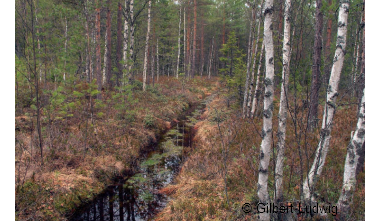Habitat change and grouse populations
Changes to the habitat either through modification or complete loss are key problems for many grouse populations. In western and central Europe, habitat loss due to changes in human land-use, and particularly the intensification of agriculture, is the major cause of black grouse declines (Ludwig et al. 2009). In addtion, drainage and destruction of moorland, fertilisation or afforestation of heathland and sheep pastures, and the declining use and maintenance of alpine summer pastures by grazing and mowing, are common causes of the black grouse habitat deterioration. Overgrazing from livestock or deer can also destroy ground vegetation and the associated invertebrate communities is also a problem in some populations (Baines et al. 1996; Calladine et al. 2002).
In boreal regions, modern forestry may be detrimental through direct disturbance, changes in the spatial and temporal distribution of food or lack of cover (e.g. Kurki et al. 2000). In particular, loss of key food plants such as bilberry (Myrtillus myrtillus) and associated invertebrate fauna (especially lepidopteran larvae) are important food sources for both adults and chicks (Ludwig et al. 2010).
 In addition, large-scale drainage, as a means to increase timber productivity, is
likely to have had a major impact on grouse populations. Indirect affects are likely to occur through bottom-up impacts such as altered food availability or top down effects such as increase predation risk (Ludwig et al. 2008). Grouse chicks may also be vulnerable to drowning (Ludwig et al. 2008). Modern forestry practisies such as clear-cutting favour adaptable meso-predators such as foxes, and increased predator densities can directly impact grouse populations (Wegge & Rolstad 2011).
In addition, large-scale drainage, as a means to increase timber productivity, is
likely to have had a major impact on grouse populations. Indirect affects are likely to occur through bottom-up impacts such as altered food availability or top down effects such as increase predation risk (Ludwig et al. 2008). Grouse chicks may also be vulnerable to drowning (Ludwig et al. 2008). Modern forestry practisies such as clear-cutting favour adaptable meso-predators such as foxes, and increased predator densities can directly impact grouse populations (Wegge & Rolstad 2011).
References
Baines, D. (1996) The implications of grazing and predator management on the habitats and breeding success of black grouse Tetrao tetrix. Journal of Applied Ecology, 33. 54-62.
Calladine, J., Baines, D. & Warren, P. (2002) Effects of reduced grazing on population density and breeding success of black grouse in northern England. Journal of Applied Ecology, 39, 772-780.
Ludwig, G. X., Alatalo, R.V., Helle, P., Nissinen, K. & Siitari, H. (2008) Large-scale drainage and breeding success in boreal forest grouse. Journal of Applied Ecology 45, 325-333.
Ludwig G. X., Alatalo R. V., Helle P. & Siitari H. (2010) Individual and environmental determinants of early brood survival in black grouse Tetrao tetrix. Wildlife Biology, 16, 367–378.
Ludwig, T., Storch, I. & Gärtner, S. (2009) Large-scale land use change may explain bird species declines in semi-natural areas: the case of black grouse population collapse in Lower Saxony, Germany. Journal of Ornithology, 150, 871-882.
Kurki, S., Nikula, A., Helle, P. & Lindén, H. (2000) Landscape fragmentation and forest composition effects on grouse breeding success in boreal forests. Ecology, 81, 1985-1997.
Wegge, P. & Rolstad, J. (2011) Clearcutting forestry and Eurasian boreal forest grouse: Long term monitoring of sympatric capercaillie Tetrao urogallus and black grouse T. tetrix reveals unexpected effects on their population performances. Forest Ecology and Management, 261, 1520-1529

